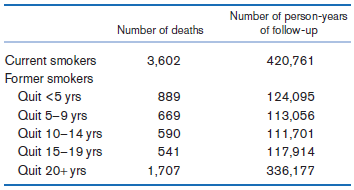The age-adjusted rate ratio between the groups in Problem 14.51 was 0.34. Is this different from the
Question:
Health Promotion
A recent, article by Kenfield et al. [12] studied the relationship between various aspects of smoking and mortality among 104,519 women in the Nurses€™ Health Study (NHS) from 1980ˆ’2004. One issue is whether there is a mortality benefit from quitting smoking vs. continuing to smoke and, if so, how long it takes for the mortality experience of former smokers to approximate that of never smokers. The data in Table 14.35 were presented comparing former smokers with current smokers.
Table 14.35: Relationship of time since quitting to total mortality

Fantastic news! We've Found the answer you've been seeking!
Step by Step Answer:
Related Book For 

Question Posted:





